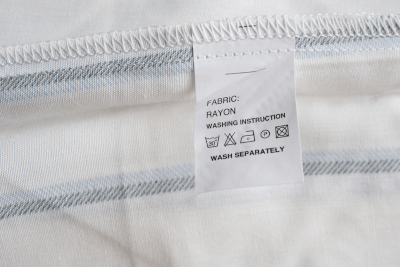What Is Rayon?

Rayon is a chemical fiber manufactured from wood and other plant materials.
It is a counterpart to natural fibers such as cotton, hemp, silk, and wool. The history of rayon is said to have begun around the late 1800s. At that time, rayon was made from silkworms and other naturally occurring fibers, but silkworms were often in short supply, and research into the production of artificial fibers from plant materials was actively conducted to cope with this situation.
Before rayon was developed, acetate (cellulose acetate) and copper ammonium rayon (Cupra) were developed. However, the former was shiny and beautiful but difficult to dye, and the latter was expensive because it used cotton as a raw material.
In response to the demand for inexpensive fibers, C.F. Cross, E.J. Bevan, and C. Beadle in England developed a process that used wood pulp, a cheaper raw material than cotton. In the 1900s, industrialization began, and rayon is now used in many countries around the world.
Uses of Rayon
The main uses for rayon as a fiber are for interior goods, such as sheets, curtains, clothing, and underwear, as well as for clothing. Since rayon is said to have a feel similar to silk, it is often used in clothing that is thin and has a particular feel to the skin, and it also has the advantage of being inexpensive to manufacture.
Although mostly used for clothing, rayon is also used for tire cords that form the framework of tires and surgical tools, making it an indispensable material in industry.
Properties of Rayon
Rayon is mainly composed of cellulose, which is abundant in plants. It is classified as a regenerated fiber among synthetic fibers because cellulose is chemically treated to form a solution and then regenerated into fiber.
Rayon is a polymer like polyester and nylon, but its degree of polymerization is about 300, which means that its molecular weight is smaller than that of synthetic fibers. Since it is produced from naturally derived raw materials, it has the property of being decomposed by microorganisms in nature.
Characteristics of Rayon
Rayon’s advantages include its pleasant texture, luster, easy dyeing and excellent coloring properties, excellent draping properties, and heat resistance. Another advantage is its high antistatic property, which reduces the generation of static electricity.
In particular, its air permeability and moisture absorbency make it suitable for lining not only summer clothes but also winter clothes. On the other hand, its disadvantages are that it is weak against water and becomes extremely weak when it absorbs moisture, shrinks easily when washed, and has low dimensional stability. These are characteristics different from those of synthetic fibers, so care must be taken in daily handling.
Types of Rayon
When labeling fibers, if the average degree of polymerization is 450 or higher, the fiber is labeled as Rayon, RAYON, or polynosic. In all other cases, the fiber is labeled as Modal, or RAYON.
Polynosic is the name for fibers with a high degree of polymerization and high crystallinity among Rayon fibers. Polynosics are strong, water-resistant, and dimensionally stable. It is also characterized by its firmness and elasticity compared to Rayon, and by its ability to produce fine denier fibers.
Modal, a fiber registered as a trademark by the Australian company Lenzing, is also classified as Rayon. It is labeled as Rayon (Modal) on fiber labels. Modal is made from beechwood, making it more water-resistant and stronger than rayon, which is made from a mixture of several types of wood.
Other Information on Rayon
How Rayon Is Manufactured
Rayon is manufactured by dissolving alkali-treated cellulose material in carbon disulfide and spinning it in an acidic solution such as sodium sulfate. The solution dissolved in carbon disulfide is called viscose, and rayon is sometimes described as viscose rayon or viscose fiber.
When it was first developed, rayon had the fatal disadvantages of weak tensile strength and flammability, but from later research, the disadvantages were overcome by adding additives during rayon production, as it was made into a fiber. Therefore, rayon today is a fiber that possesses the characteristics of both natural and synthetic fibers.